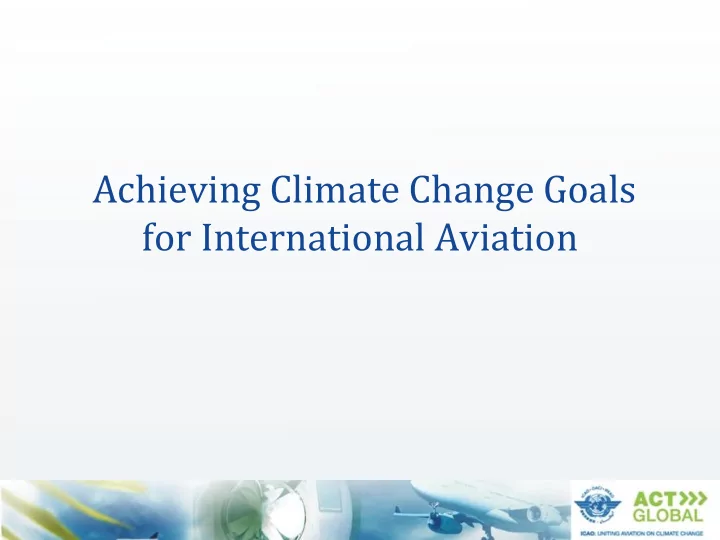

Achieving Climate Change Goals for International Aviation
Aviation Emissions in Context • Fast, reliable, and safe mode of transport • No comparative alternatives for long haul passenger transport • 2.3 billion passengers per year carried worldwide • Scheduled passenger traffic worldwide forecast to grow at ~4.7% per year • Aircraft produced today are 70% more fuel efficient than 40 years ago • First sector with a special IPCC report (1999) • Responsible for up to 8% of global economy Global GHG Emissions by Sector, 2004 Global Transportation CO 2 Emissions, 2000 Aviation’s Global CO 2 Emissions, 2000 (Int’l Aviation’s Contribution was ~1.2%) Residential and Aviation CO 2 Commercial Buildings Aviation Emissions Agriculture 8% 2% 13% 14% Waste and Transport Other 13% 3% Wastewater 13% Forestry Road Global CO 2 17% 26% Energy Supply Emissions 74% Source: IPCC 98% 19% Industry
ICAO and UNFCCC Working Together • UNFCCC / Kyoto Protocol: • Domestic aviation emissions • ICAO: • International aviation emissions • “It is vital that ICAO and the UNFCCC meet the challenge of climate change in a complementary fashion.” Christiana Figueres , Executive Secretary of the UNFCCC
Where We Have Been 600.0 0.6 0.5 Fuel Efficiency (Fuel per RTK) 500.0 Fuel Consumption (Mt) 0.4 400.0 0.3 300.0 0.2 200.0 0.1 100.0 0 0.0 -0.1 1990 1992 1994 1996 1998 2000 2002 2004 2006 2008 2010 Actual Fuel Consumption Fuel Efficiency (Fuel per RTK)
Where We Are Going CAEP/8 Aviation CO 2 Trends to 2036 International Traffic Only 1400 1200 Technology and operations 1000 2% Annual Fuel CO 2 Mt 800 Efficiency Improvement Alt. Fuels and Economic 600 Instruments 400 200 0 2006 2012 2018 2024 2030 2036 5
ICAO Analysis Conclusions • 2% annual fuel efficiency goal to 2020 likely to be achieved • Feasibility of more ambitious goals depends on work in all areas identified by the High-level Meeting – no single element can achieve the goals alone – Technology, Operations, Alternative Fuels, Economic Instruments • Measures need to be applied as appropriate based on local circumstances
EC Conclusions • A number of studies have demonstrated that it is feasible to set ambitious reduction goals for aviation • Cost effectiveness can be assured by allowing access to lower cost reduction in other sectors (international credits / offsets) • The EU considers that a net 10% reduction in GHG emissions below 2005 levels by 2020 to be achievable • Technical, operational and market based measures should be pursued
Results for U.S. Aviation Can Achieve Carbon Neutral Growth
Industry Emissions Reduction Roadmap “Frozen technology” emissions Known technology, operations and infrastructure measures No action Biofuels and additional technology CO 2 emissions Carbon-neutral growth 2020 Tech Gross emissions trajectory Ops Economic measures Infra Biofuels + CNG 2020 add. Tech -50% by 2050 (schematic) 2005 2010 2020 2030 2040 2050
Overall Conclusions • Technology and operational efficiency make the 2% annual fuel efficiency goal until 2020 achievable • Various analyses have shown the feasibility of achieving more ambitious goals at the State and the Regional levels • Combination of measures need to be applied, as appropriate, based on local circumstances
For more information www.icao.int 11
Recommend
More recommend